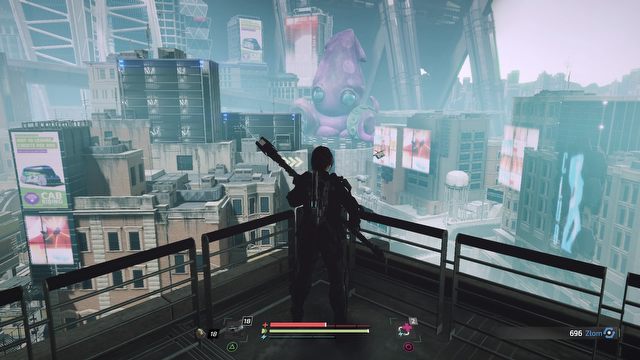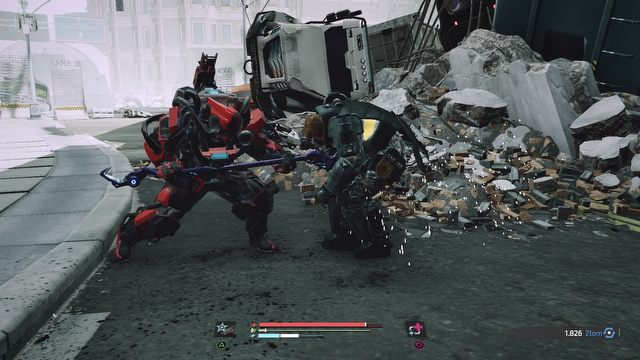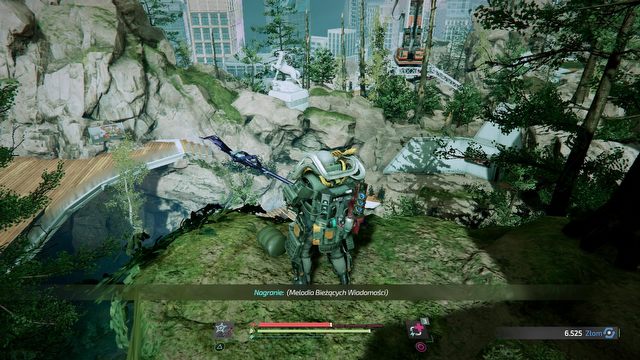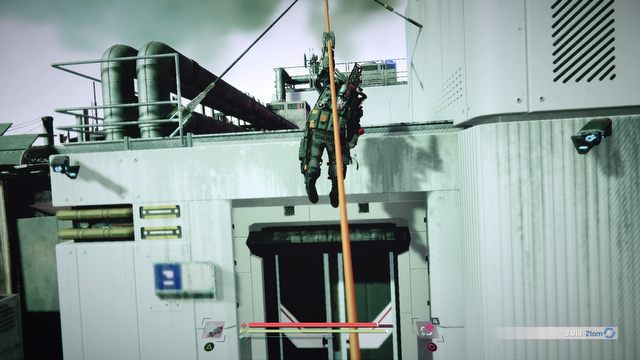The Surge 2 Review – Futuristic Dark Souls
The Surge is a properly realized, and distinctive game inspired by Dark Souls. Unfortunately, the inconsistencies in the mechanics and graphics departments produce some rather glaring issues.
The review is based on the PS4 version. It's also relevant to PC, XONE version(s).
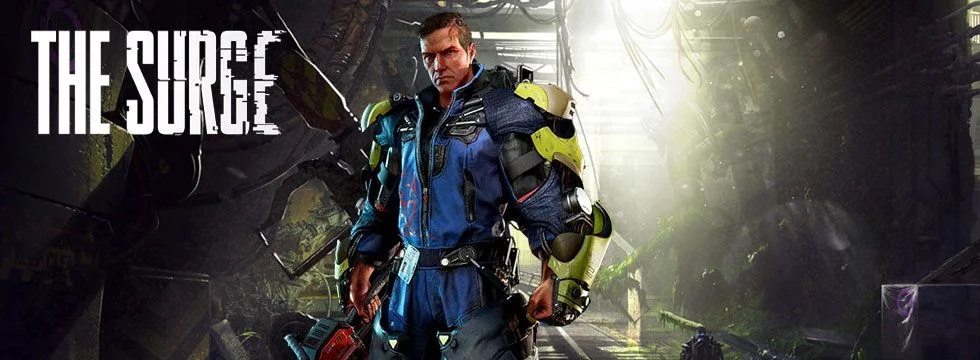
The Surge 2 is a Dark Souls, only that:
- It’s much easier;
- It’s set in a dark science-fiction universe;
- It has a very dynamic combat system, which sometimes makes the game seem more similar to Devil May Cry than the sluggish pounding in the Souls;
- It’s paying much more attention to fighting regular opponents than bosses.
- Level design is much more thoughtful than in the prequel – unreasonably big gaps between medical stations are no more;
- A captivating picture of dystopian future;
- Excellent, dynamic and diverse combat system;
- A new mechanism of evaporation gives combat a new dimension;
- The game is addictive and gripping from beginning to end.
- The difficulty might be too low for some;
- Only some boss fights were interesting.
The Dark Souls series is said to have established a new subgenre of slasher/action games, referred to as "souls-like." However, if we were to look for souls-like outside of the FromSoftware's portfolio, it turns out that there's not a whole lot of these games – even less if we get picky about quality.
This exclusive club certainly includes the original Surge, from the German Deck13 Interactive studio. Released in 2017, the game came short in many places, and the budget constraints were quite apparent. However, the sci-fi stylistics, rather uncommon in the genre, along with an interesting combat system, made it worth the time of all the players who wanted more of the same thing after praising the sun in all ways possible.
The game was a success, and we got a follow-up. The Surge 2 is definitely an upgrade from its predecessor. It's big, it mends the biggest shortcomings of the prequel, refines its best elements. This still isn't From-Software tier, but it is a decisive step in the right direction. At the same time, however, this game may be disappointing to the biggest, die-hard fans of souls-like games, since it doesn't deliver the core ingredient – a very high level of difficulty.
Jericho flights
The Surge 2 begins with character creation. The tool is robust and offers quite a few interesting options, such as choosing the origin story of the protagonist (which, admittedly, doesn't change anything in the gameplay), or creating a character that's visibly old. Regardless of what character we create the protagonist will, in the end, sit on a plane that crashes in the center of a futuristic city of Jericho.
We miraculously survive the catastrophe and come round a few weeks later in a local prison, where we quickly discover the entire city is a war zone, ravaged by the conflict between the Nanites – religious fanatics at all cost trying to keep power over their soldiers – and different groups of freaks, coming in various sizes. Amidst this chaos, we're haunted by strange visions of a mysterious girl, who apparently flew on the same plane as we did. With no better idea, we decided to solve the mystery of these omens, and the young woman.
The plot of The Surge 2 is average – the intrigue is revealed gradually, and although it's more interesting than the bland story of the first game, it's void of any significant turns of events or charismatic characters that could make the experience at least a bit more riveting. In addition, the side quests also hardly offer anything substantial that would stay with us for longer. What certainly deserves praise is that the developers have told this story through traditional means, making it easy to digest – you don't have to read the description of every single item to get the gist of what's going on.
The greatest power of the game comes from the creation of the world. Like the industrial complex of the first game, the city of Jericho is an extremely gloomy place, where even before the conflict life was not all sunshine and bunnies. With every street and building visited, we learn more about the story of this place – the story of humanity, which led itself to the brink of death, maybe even past it. There are billboards boasting of unemployment rates "as low as 85%," there's a park that turns out to be completely phony, a mere imitation of the long-gone nature; there's the decay of the few survivors, which makes you wonder if there's anything worth fighting for anymore.

HOW DOES THAT COMPARE TO THE FIRST SURGE?
A new protagonist created by the player, taking the action to a remote city, far from the CREO complex – it sounds like The Surge 2 is severing all the plot ties with its predecessor. But that's not true. As the story progresses, several references to the events of the first part of the series are revealed, some of them more explicit than others. Apart from that, those of you who have played the original will also be able to recognize a familiar face among the cast of NPCs.
The link between the two games isn't very strong, however, and jumping into the story without knowing the plot of the first game is entirely doable. Still, the "veterans" of the series should also be satisified.
Souls-like indeed
Similarly to the original, The Surge 2 is a genuine souls-like game, brimming with features characteristic for this subgenre. It is an action RPG that's mainly emphasizing combat. The core of the gameplay is breaking through subsequent groups of enemies to reach the safe shelter of a medical station, or unlock a shortcut to one of these places discovered before.
You get experience points for each defeated enemy (here, they're just called scrap), but if you make a mistake and die, you lose all that. It's possible to go back to the same spot to retrieve it, but you only get a single chance to do it – flunk it again, and it's lost permanently. We can safely store the scrap in the medical stations, where you're also able to upgrade your character – that's not free either, though, as the price for each use of the station is a full respawn of nearby enemies.
From time to time, we also encounter bosses, who theoretically should test our perseverance and skill. According to the genre's rules, overcoming a boss should require studying the attacks they use, drawing conclusions from each failure, and testing different approaches until the solution is finally discovered. However, when it comes to those mechanics, the game noticeably falls short of Dark Souls. But more on that later.
A walk in the park
The Surge 2 is a much easier game than you would expect. Don't get me wrong – the game from Deck13 can still punish a single error with death, making you repeat the same section numerous times. This, however, has nothing in common with the rites of passage served by the Dark Souls, or even the first Surge.
Curiously enough, this stems from eliminating the greatest pitfall of the original – that is, reducing the gaps between the medical stations. I can still remember the frustration from having to repeat portions of the game that were sometimes twenty-minutes long, forcing me to repeatedly break through the exact same corridors, before I finally managed to reach a station. In The Surge 2, the level design is much more thoughtful, and just as the excess of the accumulated scrap becomes burdensome, we can expect a safe heaven is nearby. Thanks to that, we rarely have to repeat substantial portions of the game, consisting of fighting the same opponents. In the worst case, we're looking at a few minutes' worth of sprinting for our dropped loot.
The gameplay is also facilitated by an extensive system of character development. Not only does it allow us to freely grind health points or stamina (which was heavily restricted in the original), but it also gives access to very useful modules at an early stage of the game, thanks to which, for example, we can very effectively restore health by defeating enemies.
If, in spite of all this, we still die, our loot has to be retrieved in the given time – but as long as the corpse is there, it provides area-of-effect health regeneration. Using this mechanic can provide a huge advantage in boss fights, and can render regular encounters banal.
It's not really Ornstein and Smough
Right, the bosses. The thing that surprised me the most was that there are relatively few of them in the entire game. While boss fights are the cornerstone of Dark Souls, where the entire gameplay boils down to traveling from boss to boss, with regular enemies being a mere distraction, or just straight-up cannon fodder useful only for grinding, in The Surge 2, some boss encounters are hours apart. We spend most of the time engaged in a danse macabre with regular enemies, with the proportions only changing towards the end of the game, where the likelihood of running into a boss noticeably increases.
The surprise number two was the complexity of these encounters. While there were some optional bosses that posed a real challenge, about ten of the mandatory enemies were usually really easy. Suffice it to say that I overcame most of them in the first approach – some of the final enemies included. The rest I was able to defeat in three to four attempts. This is partly due to the fact that most opponents are simply buffed reiterations of regular enemies, and by the time you meet them, you must have mastered the strategy effective against their regular variants.
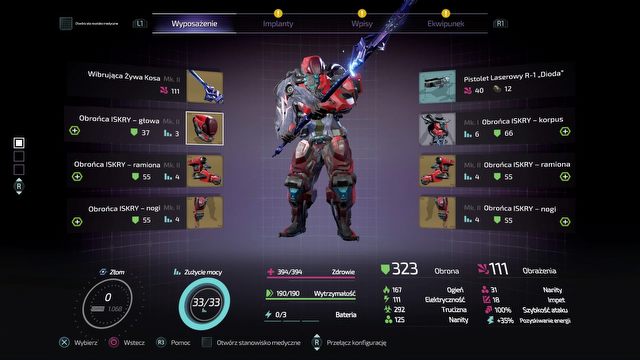
While the proverbial monkey wrench was the only weapon we had in the first game for quite a long time, here, it's not long before we can start using some serious toys.
The only bosses that offered a genuine challenge were the final boss, and the characteristic robot known from the game's cover. The latter was also the most souls-like opponent. While I dealt with the other bosses by simply using the same strategy I'd used with their regular, mob versions – perhaps with some minimal adjustments – in case of that boss, I really had to carefully watch his moves, learn his patters, look for exploitable gaps in defense, and plan attacks well. And learn from my own failures, too. It is a pity that neither of the remaining opponents offered similarly interesting challenges, and the encounters with them were effectively unremarkable. The additional bosses also didn't offer a respite – those that I encountered were merely buffed-up versions of the regular enemies I had already defeated. As far as I can tell, there are no other types of extra opponents in the game.
Lend me a helping hand
Bosses are not the advantage of The Surge 2 but, as I said, the game doesn't emphasize the clashes with them so strongly. The heart of the game is normal combat with regular enemies – street thugs possessed by the Nanites, religious fanatics, armored soldiers, or machines.
The combat system is an extension of an interesting solution known from the first Surge. There are six distinct areas on the body of any boss – the head, torso, and each limb. Some opponents may have armor on different parts of the body, and we can decide – during the fight or beforehand – which part we want to attack. If we choose a body part without protection, we will deal much more damage and throw the enemy off balance more easily. Attacking armored parts isn't that effective, but when we break enough of it, we will be able to perform a special attack and get a scheme for the given part of the armor – high-risk-high-reward at its best.
The most significant novelty is the parrying mechanism. You can of course always dodge, but risking a parry can sometimes pay off. This requires pressing the button corresponding to the direction of the incoming attack with perfect timing. If we mess the timing, we receive considerable damage, but success is rewarded with the opening of the enemy's guard, offering the perfect chance to deal large damage. The timing is problematic with faster enemies who rain down their attacks, and dodging often seems the better alternative, but with larger, more ponderous enemies, parrying works great and provides a welcome diversification of the combat system. Personally, I needed a few hours to really internalize this mechanic and start treating it on par with the remaining moves, but towards the end of the game, I used parrying with pleasure.
The battles are very dynamic. At the beginning of the game, the stamina bar is enough to freely perform even a few dodges in a row, followed with a series of attacks. There are two types of attacks – fast and strong – and we can combine them in all sorts of spectacular combos, while the enemies rarely deal a lot of damage. All this renders the combat system of the game much more similar to the dance of death from slashers such as Devil May Cry or Bayonetta, rather than the ponderous swinging of swords and shields, waiting for a good moment to attack in Dark Souls. Even if you're willing to bet on parrying, the game requires such focus and precision that fighting remains very intense.
There's quite a lot weapons available (I found spears and staffs much more efficient than other weapons, and used them throughout the game) and just as many viable ways of attacking the bad guys – apart from fast or strong attacks, we can also charge the strikes, or use the drone, which can be fitted with one of the few attack modules – all this makes combat really interesting. Especially since there are aspects of the system that do pose some challenge. I mentioned above that individual hits don't do incredible damage, but the enemies tend to attack in groups, or lay down longer series of attacks, which effectively makes this system pretty punishing. Again, this isn't the Dark Souls level of difficulty, it's enough to keep you on your toes for the most part of the game.
MYULTYPLAYER
There's no traditional multiplayer in The Surge 2. Still, there are some quasi-online mechanics inspired by other games. The drone, for example, allows us to paint graffiti with hints for other players – telling them about hidden loot, or warning of a dangerous enemy. We can also place our banner somewhere – the more inaccessible the place is, the better, as other players will attempt to find it. Finally, if we die, the character that killed us will be marked in another player's session, and they will be able to avenge us, receiving a handful of additional rewards – and it works both ways, so we too can hunt down mobs that killed other players.
Walls of Jericho
I didn't find the visuals particularly astounding – the graphics seemed blurry and terribly illegible. Thankfully, this can be easily mended in the graphics settings – the devs apparently thought it a good idea to set post-processing effects of blur and flares to eleven.
Once these effects are contained, The Surge 2 becomes much more focused, and the visuals turn out quite enjoyable. This isn't the premier league, you can encounter some super blurry textures every now and then, but in general, the graphics are decent, and the game has nothing to be ashamed of when compared with most PS4 games.
Then, the optimization and fluency of gameplay deserves praise – I don't recall encountering any serious dips in the framerate, nor other serious bugs. The only thing I sometimes missed was the ability to increase the size of the text – which is currently a problem in virtually all games, as if the developers in all studios assumed we play games with our faces three inches away from the screen. The loading screens that we have to watch every time we die have also become irksome after a few hours.
Artistically, the game retains much of the style of its predecessor – we visit mainly the industrial ruins of the city, the sewage, as well as some tunnels and laboratories. About the only exception was the artificial park – an extensive location visited around the middle of the game. It's just a normal forest, actually, which probably wouldn't make a bigger impression in another game, but here, it is a very nice and welcome diversion. Similarly to the first Surge, the locations we visit are mostly bland, but you can't deny they're doing a god job of building a coherent and reliable setting, which in itself doesn't seem like the most exciting place to be.

WHAT ABOUT THE PC VERSION?
Simply put,The Surge 2 is poorly optimized on the PC. After almost 20 hours spent in the game, the constant stammering of the animation becomes unbearable, especially during the more dynamic combat scenes, or when we're quickly traveling across larger distances. Tuning the settings down from very high to high offered no respite, event though the game didn't seem to really stress the hardware. Turning adaptive vertical sync was somewhat helpful, though.
Overall, the graphics were quite specific. The contrast is really high, and the game often seems overexposed – fortunately, this can be mitigated by modifying the settings of ambient lightning, and occlusion. We played a pre-release version of the game, which got a patch that introduces TAA antialiasing (in addition to SMAA), but both of these produce very similar effects.
Our hardware:
- GPU: Gigabyte GTX 1080
- CPU: Intel i5-8400
- RAM: 16GB
- Resolution: 2560x1080 (21:9)
- Settings preset: high
Two steps to Dark Souls, and one step back
At the end of the day, The Surge 2 is a very good game. Despite all the shortcomings, this remains a compelling experience focused on combat, in which the encounters really worth their weight in gold, and remain entertaining throughout the game. We also get a well-crafted setting, pretty solid technical delivery (only on consoles), and some clever upgrades compared to the original installment.
The greatest issue I have with the game is that it's not as difficult as it should be. These games are a domain of a rather specific niche of players, who have very specific needs – the challenge must be real, it must be exhausting, it must give you a run for the money, ultimately providing satisfaction rarely experienced in other genres. And The Surge 2 doesn't have that in stock. I didn't feel especially proud when I finished the game. No more than after finishing Assassins' Creed or Yakuza.
So before you flirt with the new game from Deck13, you should make sure you're not looking for a hugely challenging experience. Otherwise, if you're a veteran of NioH, Bloodboorne, all Souls games and the original Surge, you'll be in for a disappointment. On the other hand – if you were always interested in souls-like, but you found all of the above titles intimidating and prohibitively difficult, The Surge 2 is a great way to start your adventure and see what this genre is about.
ABOUT THE AUTHOR
According to the counter in the game, completing The Surge 2 it took me 29 hours and 18 minutes. I finished the main thread and did some side quests, but skipped most of them. I also didn't fight many of the optional bosses, so if you want to really max out the game, you can easily count on a dozen or so hours more.
Of all souls-like games, my favorite is NiOh, which I think is as close to perfection as you can get. The Surge was for me an average title, deserving a solid 7/10.
DISCLAIMER
We received a copy of the game for this review free of charge from the publisher. Thanks!
The Surge
The Surge 2 Review – Futuristic Dark Souls
The Surge is a properly realized, and distinctive game inspired by Dark Souls. Unfortunately, the inconsistencies in the mechanics and graphics departments produce some rather glaring issues.



